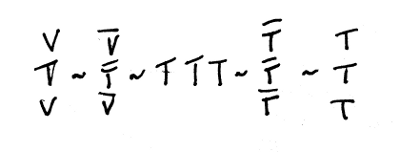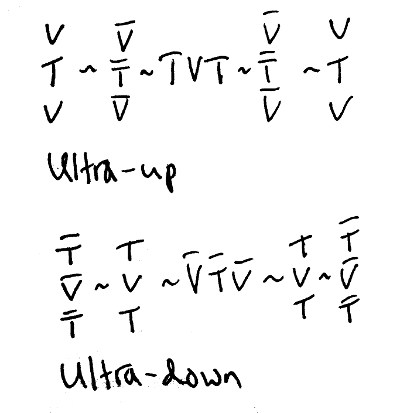Next: Higg's Boson Up: Quarks and other Elementary Previous: Where are the Bosons? Contents
Towards the beginning of this paper the startling penta-triplet layout was introduced, as a set of double-stacked I-Frames. In the case of the Tau, it is believed that the Tau comprises one outer I-Frame, with two positrons in the outer positions and a muon in the centre, the muon itself comprising two outer electrons and a central positron.
In this section we explore the possibility of other penta-triplet (double I-Frame) particles. Tentatively, the most likely acceptable layout would be for the outermost particles to be the anti-particles of the inner I-Frame's outermost particles: effectly creating a weird hybrid following both the rules of Pions and I-Frames.
What estimates could be made for the mass of the most likely-detectable of these particles, should they exist? The difference in the mass between the muon and the tau gives a rough factor of a 17-fold increase. The least heavy of all the 9-particle I-Frames is the strange quark, at 90 MeV (theoretical). It would therefore not be unreasonable to put an ultra-strange particle at somewhere around 1.53 GeV.
 figureTentative "ultra-strange" penta-triplet particle
figureTentative "ultra-strange" penta-triplet particle
|
However, look closely at which particle is in the centre, whilst the other two have cancelled out by the surrounding particles: a positron. So, although this particle could potentially exist, it would not be classified as a quark, but as a heavy anti-electron. Also, given that the combined energy of the down and anti-down at one end when compared to that of the electron and positron pair at the other is different, the centre of mass of this particular combination would be off. Chances are, then, that this particle's half-life would be immensely short, assuming it was able to remain stable at all.
So consider instead the remaining 9-Rishon I-Frame particles that are symmetrical. These are the muon, the muon neutrino, the proton and the neutron. Extending these four particles by placing anti-particles at their outer extent gives the tau, the tau neutrino, and two other possible and previously undiscovered particles. Although based on a neutron and a proton, the anti-particles would cancel out the outer up (and down) quarks respectively, leaving the central quark as the remaining balance. The temporary names for these are ultra-up and ultra-down.
 figureTentative "ultra-up" and "ultra-down" penta-triplet
particles
figureTentative "ultra-up" and "ultra-down" penta-triplet
particles
|
In both cases, in effect these are weird hybrids with the characteristics of Pions as well as I-Frames. Their stability (and therefore lifetime) would therefore be somewhat less than that of Pions, and based on the 17-fold jump in energy from a muon to a tau, we can make a reasonable guess for their masses to be somewhere around the 16 GeV mark. Also, rather startlingly, they would be the first quarks to have zero spin, due to the fact that in effect at each end is a Pion (pions have zero spin).
Looking at these particles in the figure above, a sudden suspicion arises. What would an ultra-up and anti-ultra-up comprise, in total? It would actually be a combination of five pions: four Pion-0 particles (of the up-anti-up variety) and one Pion-0 of the down-anti-down type. Or, consider an anti-ultra-up and an ultra-down. If reassembled, this would give enough material for two Pion-0 up-anti-up pairs, two Pion-0 down-anti-down pairs and one Pion- (the central quark of each of the two ultra-quarks).
In covering the phase transforms above, where have twinned five-particle combinations been necessary? Recall the Pion phase-transition to a muon and muon-neutrino, which involved an intermediate step creating exactly that. Double the estimated mass of an ultra-pion is, minus a not inconsiderable amount of energy that could potentially be binding energy, and it would appear that a candidate makeup for the W Boson has been found. We even have two potential candidates for the Z Boson: ultra-up and anti-ultra-up as one type, and ultra-down and anti-ultra-down as the other.
Note: recall above the previous note that the cube-root of the mass ratio between the W Boson and the Pion was 25:3? Five squared is 25. It has been deduced that there are five Pions in a W Boson.
Our earlier deduction about Bosons not being real particles would therefore seem to be in error. In fact, quite the opposite: their composition would appear to be real, as would also the ultra-quarks. The W and Z Bosons would appear to be nothing more than a heavier flavour of Pion.
lkcl 2016-12-29